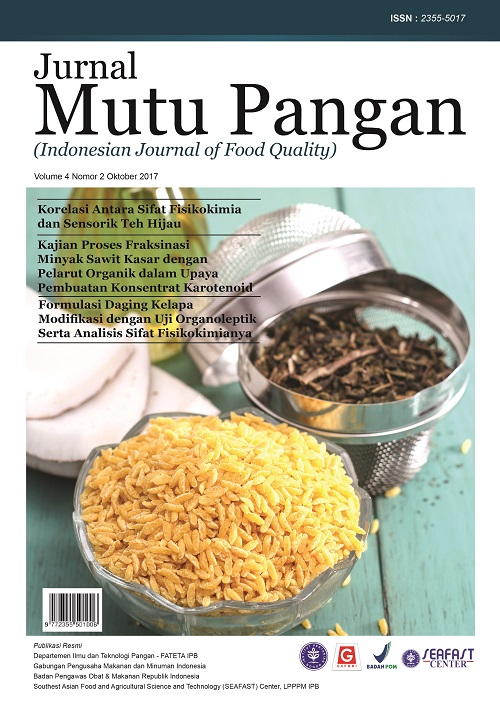Fraksinasi Minyak Sawit Kasar dengan Pelarut Organik dalam Pembuatan Konsentrat Karotenoid
Abstract
Efforts to collect carotenoid components from palm oil by crystallization fractionation method with organic solvents can improve the added value of palm oil. The objective of this research was to study the process of crude palm oil fractionation with various organic solvents and find out the types of organic solvent that can produce carotenoid concentrates with high concentration and recovery, and know the effect of organic solvent treatment on the content of tocopherol in carotenoid concentrate. This study consisted of two stages, the CPO raw material characterization stage and the solvent selection phase. The solvents used were acetone, benzene, ethanol, diethyl ether, hexane, isopropanol, carbon tetrachloride, metanol, petroleum ether, and toluene. Fractionation is carried out at gradually lowered temperatures from room temperature (2 oC) to 20oC, 15oC and lower temperature. Result showed that solvents that produce high concentrations and recovery of carotenoids at stage 1 were acetone, hexane, petroleum ether, diethyl ether, benzene, and toluene. The results of stage 2 for solvent selection showed that the sample with acetone solvent had the highest carotenoid concentration but the recovery was still low at 28.58%.
Downloads
References
AOAC. 1995. Official Method of Analysis. Association of Official Analytical Chemist. Washington DC.
Choo YM, Ng MH, Ma AN, Chuah CH, Hashim MA. 2004. Separation of vitamin E (tocopherol, tocotrienol, and tocomonoenol) in palm oil. Lipids 39(10): 1031–1035.
Derlean A. 2009. Pengaruh suhu dan lama pemanasan terhadap kerusakan minyak kelapa. Bifamik 1: 19–26.
Gritter RJ, Bobbit JM, Schwarting AB. 1991. Pengantar Kromatografi Terjemahan. Kosasih Padmawinata, Bandung: ITB.
Khomsan A, Anwar F. 2008. Sehat itu Mudah. Penerbit Hikmah, Jakarta (ID).
Kuntom A, Lin SW, Ai TY, Idris NA, Yusof M, Sue TT, Ibrahim NA. 2005. MPOB TEST METHOD: A Compendium of Test on Palm Oil Products, Palm Kernel Products, Fatty Acids, Food Related Products and other. Kuala Lumpur: Malaysian Palm Oil Board.
Mustapa AN, Manan ZA, Azizi CYM, Setianto WB, Omar AKM. 2011. Extraction of b-carotenes from palm oil mesocarp using sub-critical R134a. Food Chemistry 125: 262–267.
Nurcahyono ID, Zubaidah E. 2015. Pengaruh konsentrasi carboxymethyl cellulose sebagai edible coating dan suhu pengeringan terhadap sifat fisik dan kimia wortel kering instan. J Pangan Agroindustri 3(3): 1192–1202.
Ping BTY, Lian GEC. 2005. Spectroscopic identification of geometrical isomer of α- and β- carotenes from palm oil. J Oil Palm Res 17: 92-102.
Setyopratomo P. 2012. Produksi asam lemak dari minyak kelapa sawit dengan proses hidrolisis. J Teknik Kimia 7(1): 26–31.
[SNI] Standar Nasional Indonesia. SNI 01-0019-1995. Crude Palm Stearin. Jakarta (ID): Badan Standardisasi Nasional.
[SNI] Standar Nasional Indonesia. SNI 01-3555-1998. Cara Uji Minyak dan Lemak. Jakarta (ID): Badan Standardisasi Nasional.
[SNI] Standar Nasional Indonesia. SNI-01-2901-2006. Minyak Kelapa Sawit Mentah (Crude Palm Oil). Badan Standardisasi Nasional. Jakarta.
Susanti CM, Sugiharto R, Setyani S, Subeki. 2014. Pengaruh jumlah pelarut etanol dan suhu fraksinasi terhadap karakteristik lemak kakao hasil ekstraksi non–alkalized cocoa powder. J Teknol Industri Hasil Pert 19(2): 307–319.
Vaikousi H, Lazaridou A, Biliaderis CG, Zawistowski J. 2007. Phase transitions, solubility, and crystallization kinetics of phytosterols and phytosterol−oil blends. J Agr Food Chem 55(5): 1790–1798. DOI: 10.1021/ jf0624289.
Wong ML, Tims RE, Goh EM. 1988. Colorimetric determination of total tocopherol in palm oil, olein, and stearin. J Am Oil Chem Soc 65(2): 258-261.
Zumdahl S, DeCoste D. 2012. Chemical Principles. Brooks Cole, Pacific Grove (US).

















